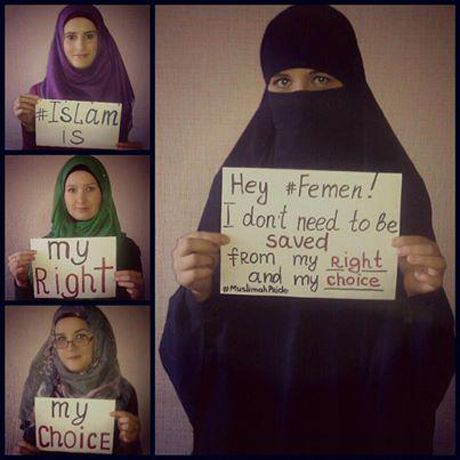Features
You are here
Racism, sexism and the fight for women’s liberation

March 7, 2014
Women have been subjected to discrimination and violence for centuries—and this oppression is sharpened by racism and Islamophobia.
Women of colour not only get discriminated against but particularly immigrant women of visible minorities. Between 2001 and 2006, 81 per cent of newcomers arriving in Toronto identified themselves as visible minorities. The unemployment rate for recent newcomer women was more than 50 per cent higher than the rate for new coming men.
As we can see from the Temporary Foreign Worker Program—which allows Canadian corporations to pay migrant workers less and to deny them basic rights—racism is used to increase the exploitation of workers. Racialized (visible minority) immigrant men in Canada earn 68.7 cents for every dollar that non-racialized immigrant men make. Sexism adds to this exploitation, with racialized immigrant women earning 48.7 cents for every dollar that non-racialized men make. One might wonder if education has anything to do with this. Well, it turns out that 40 per cent of female new comers (less than 5 years in Canada) had a university education as compared to a quarter of longer-term immigrants and a third of Canadian-born residents of European descent.
Islamophobia
It is no secret that Islam is constantly scrutinized and under siege by the Western world, and Muslim women are often its most frequent targets. Having to deal with the covert racism but also the overt racism, stares and attacks on religious headwear are more common than ever. This includes France’s ban on the niqab, Canada’s ban on the niqab during citizenship ceremonies, and Quebec’s racist charter of values—which if passed might exclude Muslim women from public sector jobs like teaching, working at hospitals. Muslim women will be even more isolated and put down.
To quote Claude Imbert, from France’s journal Le Point, “One must be honest. I am something of an Islamophobe and I’m not embarrassed to say so I have the right to think, and I’m not the only one in this country to think that Islam and I’m talking of Islam as a religion, not just Islamists is backward looking and unhealthy. It has a way of viewing women, of systematically downgrading women and wants Quranic law to supplant the law of the state. All this makes me Islamophobic.”
Islamaphobia also exists in social movements and even in some organizations that identify as feminist. One well-known example is Femen, who in the name of liberating Muslim women was extremely racist, drawing unibrows on themselves to depict themselves as Middle Eastern men. The women of femen have recently become well known for Topless Jihad Day, which includes topless protests in front of religious institutions. The group claims that staging protests while topless is the “only way to be heard” in their native country of Ukraine—which recent mass protests clearly disprove.
Femen’s “Topless Jihad Day” is said to be in response to death threats that were made to Amina Tyler – a Tunisian woman who posted nude photos of herself on Facebook with the words “I own my body; it’s not the source of anyone’s honor” written on her bare chest. Topless Jihad Day claimed to be a protest against Islam and Islamist “oppression of women.” White women wore towels on their heads, black skinny jeans and scrawled “fuck your morals” and “Free Amina” on their bare chests. In Paris, topless protesters burned a Salafist flag in front of a mosque. All of this, in the name of “liberating Muslim women.” The racism was almost too much to bear, from the unibrow to ridiculing of the Islamic prayer.
This Islamophobia echoes the justifications for wars and occupations which have increased women’s oppression. The war in Afghanistan claimed to be liberating Afghan women, but silenced the long history of women’s groups (like the Revolutionary Association of the Women of Afghanistan), and current leading women like Malalai Joya. After 13 years of brutal occupation women in Afghanistan are no better off. The same is true in Iraq, which was “liberated” by war and a decade of occupation. The result: huge levels of violence against women.
Groups like Femen often claim to speak for women of colour, but they do not understand their experiences or their perspectives on sexism and racism. Rather than challenging oppression, Femen reinforces it. Muslim Women Against Femen has since been launched to make it clear that Femen does not speak for Muslim women.
Self-emancipation
Historically, when people talk about feminism, they have focused mainly on the experiences of white middle-class women, often at the expense of racialized women from working-class backgrounds. The fight for women’s liberation must include the experiences of ALL women and must address all forms of oppression. Women of colour from working-class backgrounds have a long history of leading their own struggles and of building the fight for women’s liberation, and can speak for themselves.
Struggles differ from place to place, but it’s important to note that Muslim women have been at the heart of every struggle, like the Arab Spring for example. In Bahrain, if you see the photos of protests, the numbers of women and men protestors are equal. There are women activists and men activists at the same time. Women have been at the centre of the Egyptian revolution—from the women textile workers of Mahalla who started the strike wave leading up to 2011, to Asma Mahfouz who’s video calling on Egyptians to demand their human rights and voice their disapproval of the regime of Hosni Mubarak went viral—helping spark the revolution on January 25.
Women of colour face multiple forms of oppression, and must be able to develop their own demands, and fight their own struggles, but in a way that allows all women and men to join forces in a common cause.
Join International Women’s Day Toronto this Saturday: rally 11am at OISE, march 1pm
Section:










